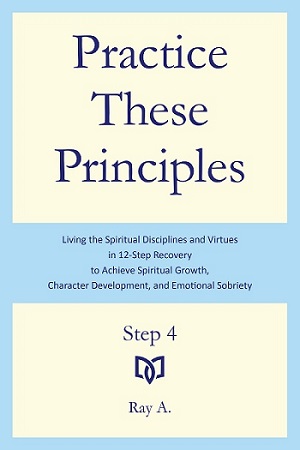
“In the preceding ten chapters we conducted a fairly comprehensive exploration of some of the principal defects of emotion (column 4 of our guide) and underlying defects of character (column 5) we would typically come across when taking inventory. In the interest of continuity, we also touched upon some of the corrective virtues.
In this part of the book, we propose to build on those latter discussions and focus on column 6 of our guide. In the present chapter we consider some of the most important features of the concept of virtue and how these coincide or conflict with those we find in the Big Book and the 12&12. With that as a foundation, in the next chapter we turn our attention to specific virtues, concentrating on their practice, the different ways they correct our defects, and the stages we go through in their acquisition. A fuller discussion of individual virtues is appropriate in subsequent Steps, especially Steps 5 through 10, which are an extension of the work we start in Step 4 and where that work comes to fruition.
We begin with a reflection on the term virtue. While the Big Book and the 12&12 sometimes refer to character traits by this traditional name, they don’t do so in a consistent manner. In fact, in contrast to defect, virtue is not an important part of their lexicon. The word and its cognates appear only 12 times in them (compared to 73 for defects): eleven in the 12&12 and once in the Big Book. Moreover, as we shall have occasion to discuss, their use of the term is sometimes problematic. This reflects in part an ambivalence about the concept that is commonplace in our culture. This is hardly a modern phenomenon, however. It can be traced back to ancient Greece. Consider the words of one Athenian general to Socrates:
"When I hear someone discussing virtue and wisdom, especially a true man worthy of the topic, I am delighted beyond measure . . . but when a man’s words and actions do not agree, it annoys me.”1
This negative baggage was to grow heavier with time, especially as virtue became associated with the holier-than-thou pretensions of a certain brand of religious morality. The Protestant Reformation’s wholesale rejection of the concept, and Luther’s derision of Aristotle as “a buffoon” who had misled the Church, added to the skepticism and suspicion surrounding the term. Modern psychology’s movement away from notions of character and morality further sidelined the concept, as we have already argued.
Given this general history, it is not surprising that AA should have adopted a skeptical attitude toward the word. But there were two additional reasons which had to do more specifically with the history of AA itself. One was the dominance of Freudian psychoanalysis during the period of AA’s formation. As we noted, this was reflected most sharply in the debates surrounding the writing and editing of the Big Book, during which an agnostic-atheist faction argued for a religion-free, psychological approach to recovery. Another was AA’s origins in the Oxford Group. . . Therefore, though the AA faction that wanted to keep God and religion in the program was made up of Group sympathizers, their stance had little to do with the kind of moral philosophy traditionally associated with virtue.
The Group’s circumvention of the concept added to the wariness which the Big Book and the 12&12 exhibit in their use of the word. As with sin, vice, defect, and even God itself, they didn’t want “virtue” to become a semantic disincentive to recovery. Hence, they opted for generic expressions. They speak of assets, attributes, concepts, keynotes, practices, precepts, qualities, standards, strengths, tenets, themes, tools, traits, and values. Obviously, some of these terms are better than others. Still, they are all too broad and applicable to too many different things. This overgeneralization and imprecision, which is also shown in the use of the word “principles,” is one of the reasons why many of us might find it hard to get a handle on what “these principles” refers to in Step 12 and how we are to practice them.”
– From Part IV: Corrective Virtues, Chapter 17, Virtue: The Concept, pp. 363-364